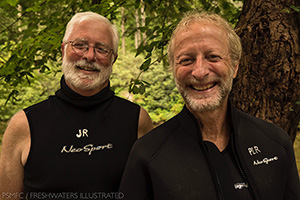
Friday, June 21, at 1 p.m., Pat Rakes will discuss—and show terrific photos of—the often hidden world of our colorful park fish in a Science at Sugarlands presentation sponsored by DLiA. Rakes has been involved in fish restoration since 1985 when he was a graduate student studying zoology at University of Tennessee–Knoxville and is now co-founder and co-director of Conservation Fisheries Inc. with partner J. R. Shute.
Frances: How did you become interested in fish and fish restoration?
Pat: I’ve kept and bred freshwater tropical fish since I was a kid and always been interested in fish behavior and ecology and marine biology. I didn’t know there was such a thing as a restoration until I started grad school at UT under Dr. Etnier. My thesis project was the life history and ecology description of the Barrens Topminnow and I immediately kept and propagated captive populations of that species and participated in restorations (now, sadly, a federally endangered species, permanently conservation-dependent).
Frances: Why is Abrams Creek an important target for restoration in the Smokies?
Pat: The Little River is currently the most diverse stream that drains the park, but most of the diversity is outside the park (90+ spp). Abrams Creek was once equivalent until it was poisoned out in 1958 after the closure of Chilhowee Dam, flooding lower Abrams and permanently eliminating most species, including three that were subsequently considered extinct. We started trying to restore four of those rare listed species in 1985 and this continues today with additional species.
Frances: What are some species that we might recognize?
Pat: Most people are most familiar with game fish like trout and bass, including the introduced non-native rainbow and brown trout, or the native southern brook trout and smallmouth bass. Nongame fish are unknown to most—they’re all just ‘minners’ or shiners. But there are dozens of those species in the park, mostly minnows and darters, as well as others like small madtom catfish. Unless you know how to collect baitfish or how to snorkel, you’ll never know that most even exist. They represent the aquatic diversity and food web base for all fish in the park.
Frances: Why are fish important for the sustainability of our planet?
Pat: Small nongame fish are aquatic “canaries in the coal mine.” They are indicator species that are the first signals of problems in our waters, be they pollution, species invasions, or climate change. And everyone knows how important water is to our existence.
Frances: What are the main challenges facing fish and/or those who study them?
Pat: The difficulty of our observing things that live underwater and ascertaining their problems. Getting in the water snorkelling and observing everything firsthand is absolutely essential.
Here I have to plug the work of our friends at Freshwaters Illustrated and their new film Hidden Rivers, which highlights these issues.
Frances: What are some of the ways guests of the park help fish thrive?
Pat: Don’t pollute or trash—everything flows downhill into water. Don’t turn over or build dams with rocks in streams—doing so destroys critical habitat for fish or even nests of eggs or larvae during spawning season. Financially support GSMA or Discover Life in America so they can afford to continue their good works.
Rakes is a member of the Southeastern Fishes Council, American Fisheries Society, North American Native Fishes Association and the Association of Southeastern Biologists.
You can also plan to attend these upcoming Science at Sugarlands events*
July 19: The National Ecological Observatory Network (NEON) and its work in the Smokies with WP “Bill” Martin, field operations manager, NEON-Battelle Ecology
August 16: The grassy balds of the Great Smoky Mountains with Jesse Webster, NPS forester
September 20: Plant-soil microbiome interactions and the Chimney Tops fire with Kendall Beals, Ph.D. student, University of Tennessee
October 18: Lichens of the Smokies revealed with James Lendemer, assistant curator, New York Botanical Garden
*All events are FREE and held at Sugarlands Visitor Center, 1420 Fighting Creek Gap Road, Gatlinburg, on Fridays from 1–3 p.m. Registration at dlia.org/sas is appreciated.
The Great Smokies Welcome Center is located on U.S. 321 in Townsend, TN, 2 miles from the west entrance to Great Smoky Mountains National Park. Visitors can get information about things to see and do in and around the national park and shop from a wide selection of books, gifts, and other Smokies merchandise. Daily, weekly, and annual parking tags for the national park are also available.